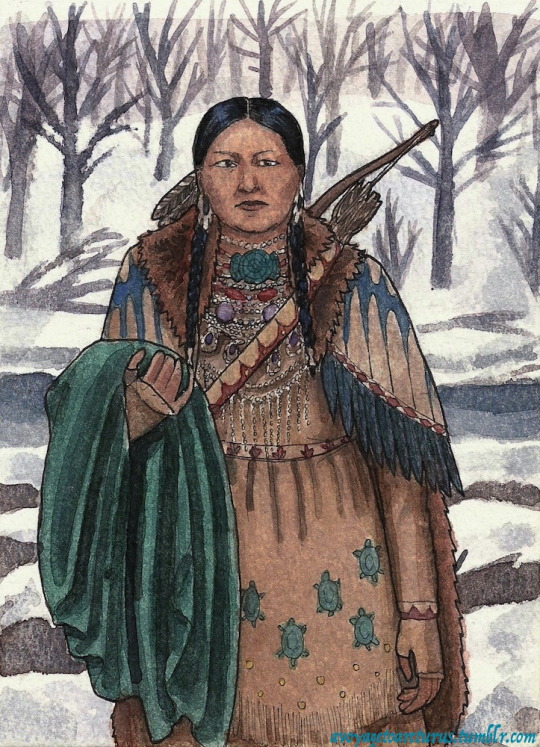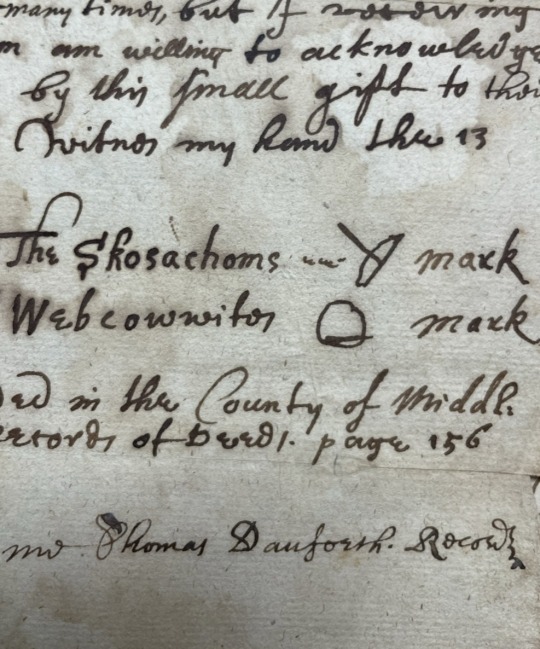#Nanepashemet
Text

**Content Warning: Racist/Misogynistic Slur**
Squaw Sachem. Squaw Sachem of Mistick. Saunkskwa of Missitekw. Skosachoms mark.
Her homelands spreading across the areas of present day Charlestown to Concord, MA. and across Massachusett, Nipmuc and Pawtucket territories. This land deed for a tract of land from so-called Charlestown and Cambridge, Massachusetts, “against the ponds at Misticke” to Jotham Gibbons. Marked on the 13th of November, 1636. Leader across several Massachusett and Pawtucket communities before, during and after the death of her first partner, Nanepashemet (d. 1619). She died in 1667.
Her Kin: Nanepashemet, a partner. Their sons, Wonohaquaham (or Sagamore John), Montowampate (or Sagamore James), and Wenepoykin (or Sagamore George). Wompachowet or Webcowit, a partner. Their daughter, Yawata (or Sarah).
This post offers an opportunity for reflection and discussion around the appropriation and derogatory meaning the Algonquian word (and once honorific term) “squaw” or “sonksqua” now holds. This document also calls to attention the lack of documentation of this leader’s Massachusett name. Despite her mark appearing on many ‘legal’ documents in the 17th century, her given name was never recorded. Perhaps Saunskskwa/Sonksqua was her chosen identity; perhaps colonizers weren’t concerned enough to record her other name(s).
Land deed, 13 November, 1636, recorded 1656. Seen @ Massachusetts Historical Society
#Massachusett#Sonksqua#Nanepashemet#Webcowit#hermark#theirmarks#17thcentury#17c#Massachusetts#algonquian#easternwoodlands#nativehistory#sachem#Cambridge#Charlestown#masshistoricalsociety
0 notes
Text
Happy Indigenous Peoples Day, from Massa-adchu-es-et land.
Also visited by the Pawtucket, Agawam, Naumkeag, and Nipmuc. Apparently this was quite the meeting place. I regularly go by one of several places called Tophet Swamp, where “Tophet” means a place of refuge and religious observation. These places, which line up along what is now the Mohawk Trail and/or Massachusetts Route 2A, might also have been stops on a sort of pilgrimage toward the seat of the sachem Nanepashemet in what is now Salem. Yeah, that Salem. Funny how these things seem to come together, isn’t it?
1 note
·
View note
Photo

Squaw Sachem of Mistick (Saunkskwa) (~1590-1667) for International Women’s Day 2021
The powerful female Massachusett chief (the “Queen of Massachusetts”) who made the deal with Governor John Winthrop of the Massachusetts Bay Colony that allowed the English to settle in most of the greater Boston area, including Cambridge, Watertown, Arlington, Medford, Winchester, Newton, Somerville, Charlestown, Malden, and Concord, in exchange for corn, wampum shell beads, and a new winter coat every winter for life.
Her tribe was troubled by a war with the Mi’kmaq from Maine (who had access to firearms through the French), resulting in the death of her husband, the former sachem Nanepashemet, and the smallpox epidemic, so an alliance with the English seemed like a strategic decision at the time. She lived most of her life by the Mystic River and Mystic Lakes in Medford. Her real name is unknown (the colonists just called her her title, Squaw Sachem, out of respect) and she signed legal documents with a little drawing of a bow and arrow.
#international women's day#massachusetts#boston#historicwomendaily#squaw sachem of mistick#women's history month#squaw sachem#international womens day#iwd#iwd2021#native american#massachusett#algonquin#17th century#1600s#saunkskwa#history#womens history#women in history#american history#watercolor art#artists on tumblr
250 notes
·
View notes
Photo

Just finished: Nanepashemet, or Sagamore John, Great Sachem of the Pawtucket Confederation
2 notes
·
View notes
Text


Webcowet. Webcowitt. Webcowwitos mark.
Massachusett. At home at the places that are today called Charlestown, Medford, Winchester, Massachusetts and surrounding areas. A pawau or spiritual leader, closely tied to the Sachem of Mistick after the death of her partner, Nanepashemet.
Photo 1: Land transfer marked in November 1636; the Sachem of Mistick references a tract of land “from Charlestown to Cambr[idge] which lays against the ponds at Mistick…”
Photo 2: The mark on this deed from April 15 1639. The deed describes land proximate to Charlestown, reserving lands along Mistick Pond for the Sachem of Mistick and her people to use for planting and hunting until her death.
Webcowitt’s Kin: Squaw Sachem of Mistick*
Seen at the Massachusetts Historical Society.
*In a previous post about the Sachem of Mistick we offered suggestions and information around the use of the term Squaw in the primary document and in subsequent references to the female sachem of Mistick. The term has been appropriated and the Algonquian word (and once honorific term) is now widely considered to be offensive and derogatory.
#webcowitt#mistick#massachusett#charlestown#cambridge#massachusetts#theirmarks#easternwoodlands#nativehistory#sachemofmistick#17thcentury#masshistoricalsociety#algonquian
1 note
·
View note